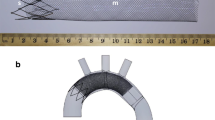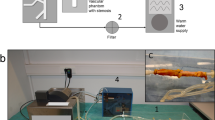Abstract
Introduction
Cerebral embolism is the principal cause of cerebral infarction. Recently, mechanical embolectomy has been proposed as an effective method. We performed a preclinical evaluation of a new mechanical clot-retrieving wire.
Methods
This clot-retrieving wire consisted of three nitinol loops at the tip of a microguidewire. These three loops could be collapsed into a 0.018-inch wire compatible microcatheter. Each loop was 8 mm long and 3.5 mm wide. For simulation, polyvinyl alcohol (PVA) vascular anatomical models of the human carotid (eight models) and vertebrobasilar (three models) circulation were constructed. A pulsatile flow circulation system was used. Embolic clots were produced using pig blood plasma. The microcatheter and the microguidewire were advanced beyond the clot. The wire was then exchanged for the retrieving wire. The microcatheter was then pulled slightly back to open the loops. The clot was then caught by withdrawal of the system. Once caught, the clot was retrieved to the guiding catheter tip. We investigated the following points: ease of device deployment, clot capture ability, clot removal against blood flow and removal of the clot out of the introducer system.
Results
A total of 104 procedures were performed in 11 PVA models and evaluated. The drop rate was 19%. We succeeded in partial and total recanalization in 51.0% of the procedures (53/104) within 30 minutes.
Conclusion
This new clot-retrieving wire could be useful for mechanical clot extraction in stroke.




Similar content being viewed by others
References
Multicentre Acute Stroke Trial—Italy (MAST-I) Group (1995) Randomised controlled trial of streptokinase, aspirin, and combination of both in treatment of acute ischaemic stroke. Lancet 346:1509–1514
Hommel M, Boissel JP, Cornu C, Boutitie F, Lees KR, Bessorn G, Leys D, Amarenio P, Bogart M (1995) Termination of trial of streptokinase in severe acute ischaemic stroke. MAST Study Group. Lancet 345:57
Donnan GA, Davis SM, Chambers BR, Gates PC, Hankey GJ, McNeil JJ, Rosen D, Stewart-Wynne EC, Tuc RR (1995) Trials of streptokinase in severe acute ischaemic stroke. Lancet 345:578–579
Multicenter Acute Stroke Trial—Europe Study Group (1996) Thrombolytic therapy with streptokinase in acute ischemic stroke. N Engl J Med 335:145–150
Cornu C, Boutitie F, Candelise L, Boissel JP, Donnan GA, Hommel M, Jaillard A, Lees KR (2000) Streptokinase in acute ischemic stroke: an individual patient data meta-analysis: The Thrombolysis in Acute Stroke Pooling Project. Stroke 31:1555–1600
Fletcher AP, Alkjaersig N, Lewis M, Tulevski V, Davies A, Brooks JE, Hardin WB, Landau WM, Raichle ME (1876) A pilot study of urokinase therapy in cerebral infarction. Stroke 7:135–142
Hanaway J, Torack R, Fletcher AP, Landau WM (1976) Intracranial bleeding associated with urokinase therapy for acute ischemic hemispheral stroke. Stroke 7:143–146
Jahan R, Duckwiler GR, Kidwell CS, Sayre JW, Gobin YP, Villablanca JP, Saver J, Starkman S, Martin N, Vinuela F (1999) Intraarterial thrombolysis for treatment of acute stroke: experience in 26 patients with long-term follow-up. AJNR Am J Neuroradiol 20:1291–1299
Arnold M, Schroth G, Nedeltchev K, Loher T, Remonda L, Stepper F, Sturzenegger M, Mattle HP (2002) Intra-arterial thrombolysis in 100 patients with acute stroke due to middle cerebral artery occlusion. Stroke 33:1828–1833
del Zoppo GJ, Higashida RT, Furlan AJ, Pessin MS, Powley HA, Gent M (1998) PROACT: a phase II randomized trial of recombinant pro-urokinase by direct arterial delivery in acute middle cerebral artery stroke. Stroke 29:4–11
Furlan A, Higashida R, Wechsler L, Gent M, Rowley H, Kase C, Pessin M, Ahuja A, Callahan F, Clark WM, Silver F, Rivera F(1999) Intra-arterial prourokinase for acute ischemic stroke. The PROACT II Study: a randomized controlled trial. Prolyse in Acute Cerebral Thromboembolism. JAMA 282:2003–2011
The National Institute of Neurological Disorders and Stroke rt-PA Stroke Study Group (1995) Tissue plasminogen activator for acute ischemic stroke. N Engl J Med 333:1581–1587
The ATLANTIS, ECASS, and NINDS rt-PA Study Group Investigators (2004) Association of outcome with early stroke treatment: pooled analysis of ATLANTIS, ECASS, and NINDS rt-PA stroke trials. Lancet 363:768–774
Molina CA, Alexandrov AV, Demchuk AM, Saqqur M, Uchino K, Alvarez-Sabin J (2004) Improving the predictive accuracy of recanalization on stroke outcome in patients treated with tissue plasminogen activator. Stroke 35:151–157
Trouillas P, Derex L, Philippeau F, Nighoghossian N, Honnorat J, Hanss M, Ffrench P, Adeleine P, Dechavanne M (2004) Early fibrinogen degradation coagulopathy is predictive of parenchymal hematomas in cerebral rt-PA thrombolysis. A study of 157 cases. Stroke 35:1323–1328
Lee KY, Kin DI, Kim SH, Lee SI, Chung HW, Shim YW, Kim SM, Heo JH (2004) Sequential combination of intravenous recombinant tissue plasminogen activator and intra-arterial urokinase in acute ischemic stroke. AJNR Am J Neuroradiol 25:1470–1475
Ribo M, Molina CA, Rovira A, Quintana M, Delgado P, Montaner J, Grive E, Arenillas JF, Alvarez-Sabin J (2005) Safety and efficacy of intravenous tissue plasminogen activator stroke treatment in the 3- to 6-hour window using multimode transcranial Doppler/MRI selection protocol. Stroke 36:602–606
Eckert B, Kucinski T, Neumaier-Probst E, Fiehler J, Rother J, Zeumer H (2003) Local intra-arterial fibrinolysis in acute hemispheric stroke: effect of occlusion type and fibrinolytic agent on recanalization success and neurological outcome. Cerebrovasc Dis 15:258–263
Bourekas EC, Slivka AP, Shah R, Sunshine J, Suarez JI (2004) Intraarterial thrombolytic therapy within 3 hours of the onset of stroke. Neurosurgery 54:39–44
Johnson DM, Kramer DC, Cohen E, Rochon M, Rosner M, Weinberger J (2005) Thrombolytic therapy for acute stroke in late pregnancy with intra-arterial recombinant tissue plasminogen activator. Stroke 36:e53–e55
Fava M, Loyola S, Huete I (2000) Massive pulmonary embolism: treatment with the Hydrolyser thrombectomy device. J Vasc Interv Radiol 11:1159–1164
Bellon RJ, Putman CM, Budzik RF, Pergolizzi RS, Reinking GF, Norbash AM (2001) Rheolytic thrombectomy of the occluded internal carotid artery in the setting of acute ischemic stroke. AJNR Am J Neuroradiol 22:526–530
Nishida T, Nakamura M, Tsunoda T, Iijima R, Shiba M, Wada M, Nakajima R, Kitagawa Y, Yajima S, Wakayama M, Shibuya K, Yamaguchi T (2002) A case of acute myocardial infarction treated with a new thrombectomy system. Catheter Cardiovasc Interv 55:239–243
Siegel RJ, Gunn J, Ahsan A, Fishbein MC, Bowes RJ, Oakley D, Wales C, Steffen W, Campbell S, Nita H, Wills T, Silverton P, Myler RH, Cumberland DC (1994) Use of therapeutic ultrasound in percutaneous coronary angioplasty: experimental in vitro studies and initial clinical experience. Circulation 89:1587–1592
Rosenschein U, Roth A, Rassin T, Basan S, Laniado S, Miller HI (1997) Analysis of coronary ultrasound thrombolysis endpoints in acute myocardial infarction (ACUTE trial): results of the feasibility phase. Circulation 95:1411–1441
Berlis A, Lutsep H, Barnwell S, Norbash A, Wechsler L, Jungreis CA, Woolfenden A, Redekop G, Hartmann M, Schumacher M. (2004) Mechanical thrombolysis in acute ischemic stroke with endovascular photoacoustic recanalization. Stroke 35:1112–1116
Smikahl J, Yeung D, Wang S, Semba CP (2005) Alteplase stability and bioactivity after low-power ultrasonic energy delivery with the OmniSonics resolution system. J Vasc Interv Radiol 16:385–389
Mayer TE, Hamann GF, Brueckmann HJ (2002) Treatment of basilar artery embolism with a mechanical extraction device: necessity of flow reversal. Stroke 33:2232–2235
Martinez H, Zoarski GH, Obuchowski AM, Stallmayer MJ, Papangelou A, Airan-Javia S (2004) Mechanical thrombectomy of the internal carotid artery and middle cerebral arteries for acute stroke by using the retriever device. AJNR Am J Neuroradiol 25:1812–1815
Becker KJ, Brott TG (2005) Approval of the MERCI clot retriever. A critical view. Stroke 36:400–403
Ohta M, Handa A, Iwata H, Rufenacht DA, Tsutsumi S (2004) Poly-vinyl alcohol hydrogel vascular models for in vitro aneurysm simulations: the key to low friction surfaces. Technol Health Care 12:225–233
Roach MR, Scott S, Ferguson GG (1972) The hemodynamic importance of the geometry of bifurcations in the circle of Willis (glass model studies). Stroke 3:255–267
Steiger HJ, Liepsch DW, Poll A, Reulen HJ (1988) Hemodynamic stress in terminal saccular aneurysms: a laser-Doppler study. Heart Vessels 4:162–169
Kerber CW, Heilman C (1992) Flow dynamics in the human carotid artery: I. Preliminary observations using a transparent elastic model. AJNR Am J Neuroradiol 13:173–180
Gailloud P, Muster M, Piotin M, Mottu F, Murphy KJ, Fasel JHD, Ruefenacht DA (1999) In vitro models of intracranial arteriovenous fistulas for the evaluation of new endovascular treatment materials. AJNR Am J Neuroradiol 20:291–295
Sugiu K, Martin JB, Jean B, Gailloud P, Mandai S, Ruefenacht DA (2003) Artificial cerebral aneurysm model for medical testing, training, and research. Neuro Med Chir (Tokyo) 43:69–73.3
Conflict of interest statement
We declare that we have no conflict of interest.
Author information
Authors and Affiliations
Corresponding author
Rights and permissions
About this article
Cite this article
Asakura, F., Yilmaz, H., Abdo, G. et al. Preclinical testing of a new clot-retrieving wire device using polyvinyl alcohol hydrogel vascular models. Neuroradiology 49, 243–251 (2007). https://doi.org/10.1007/s00234-006-0181-1
Received:
Accepted:
Published:
Issue Date:
DOI: https://doi.org/10.1007/s00234-006-0181-1




